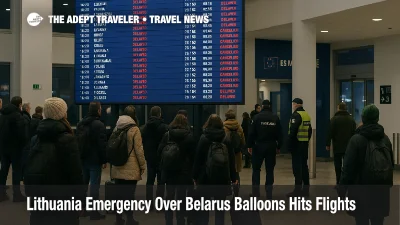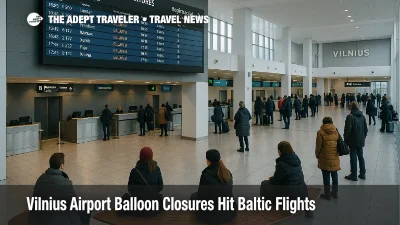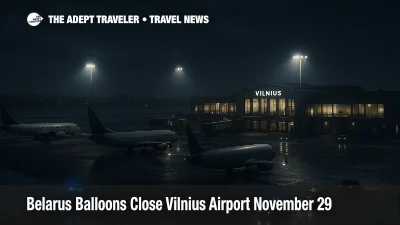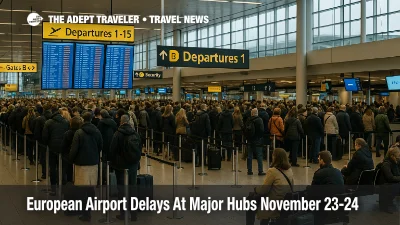Lithuania
Stepping into Lithuania feels almost like walking through a well-loved, time-worn book— each page revealing whispering forests, amber-kissed Baltic coastlines, and the cobblestones of Vilnius echoing tales of a thousand years. Where do I even begin? Imagine winding your way through narrow, medieval streets, the scent of freshly baked žemai?i? pancakes teasing the air, leaving you questioning which tiny cafe you’ll dive into next for a taste. But then you catch the faintest strains of a softly played accordion, luring you towards a square where saffron and emerald folk costumes infuse the scene with vibrancy, much like a painter’s brush breathing life into a canvas. Picture gauzy Lithuanian mornings, dew clinging to the endless green horizons of Aukštaitija National Park, and suddenly it strikes me how in moments like these, the world is both vast and intimate. A paradox, really, because isn't it odd how Lithuania can feel vast and intimate, all at once? So maybe I should ask—is there such a thing as a place feeling caught between times? Spices from a bustling market clamor for your attention, intermingling with the aroma of cepelinai, or maybe that’s just my mind getting carried away, forgetting where one thought ends and another begins. Anyway, I find myself curious—curiosity often does stray like this, doesn’t it?—wondering if you, like me, feel that restless tug to travel, to explore, yet it’s not just any exploration but a desire to travel to Lithuania, specifically. Or is it maybe certain places that shape us, and how sometimes we shape them right back with our endless imaginations and anticipations—something I mused over more times than I care to admit. Travel to Lithuania, then, not merely for the sights, but maybe, just maybe, for the stories yet to be written and those waiting to be remembered.
Lithuania Travel Season
You know, when you think about the best time to travel to Lithuania, it’s like, there's this intricate dance between seasons. It's fascinating. To see Lithuania wrapped in the vibrancy of its peak season, you'd absolutely love summer. Summer in Lithuania, it breathes life into everything. June through August, that's when the vibe is alive. Streets bustling with locals and tourists, lively festivals, and the kind of warmth that beckons you to join in. But, thinking more on this, summer does mean it gets crowded. Loads of people flocking to the beaches of Palanga and Nida. If your cup of tea is quieter exploration, then maybe, just maybe, the subtle charms of another season might call to you.
If I'm rambling on about alternatives, autumn—I'm talking September, early October—could be it. It's as if the crowds whisper away gently. The weather, still pretty pleasant, let's you truly engage with Lithuania's landscapes. And there's something mesmerizing about Trakai Castle surrounded by fall foliage, isn't there? Speaking of engagements, you might catch the Harvest Festivals during this time. It's odd, don't you think, how seasons can dictate the tempo of one's travels? Like weaving through a tapestry of sights and sounds unique to each turn of month.
Oh! Nearly forgot winter. Now, I know what you're thinking—Lithuania, winter, brr, right? Yes, it's cold, sorta bites your nose cold, but bear with me here. The charm of Lithuanian winter wraps itself in a mystical snow blanket. Vilnius’ Old Town sparkles with Christmas markets in December. It’s that fairy-tale vibe, if I can say so. And for those loving a bit of solitude, winter offers. Although, travelers beware, some attractions might take a break until the thaw. A caveat worth noting, perhaps.
Now, spring feels like the underdog, the season often overlooked when planning travel to Lithuania. But picture this: nature unfurling gently and Vilnius waking up after its snowy nap. It's a special awakening, tinged with pastel blossoms and a refreshing spirit. Honestly, it's pretty good. Yet, if I give it a thought, it’s rare you hear folks say, "I'm heading to Lithuania for spring." Maybe it’s because it straddles that fine line between chill and warmth. An enigma wrapped in a season if there ever was one.
Come to think of it, travel is like a conversation with time. When considering travel to Lithuania, you engage in a dialogue with its seasons, each offering an invitation that resonates differently for everyone. And as with any conversation, it shifts shape the further you delve into it. So, try thinking of each visit to Lithuania, each travel season as a chapter, offering a fresh feel.
The Weather and Seasons in Lithuania
Weather in Lithuania is truly something to ponder—it's like the country itself is a tale of seasons, each with its own distinct personality. When you travel to Lithuania, you'll notice how it shifts and adapts, each month marked with its own unique charm. Winters, let's dive into that first, well, they are authentically cold. Temperatures regularly drop to around 20°F (-6°C) with chilly winds that make you appreciate the cozy indoors. They're not shy about sharing some snow, which can add a quiet magic to landscapes. Imagine walking through Vilnius with snowflakes gently falling—it's almost romantic.
Spring in Lithuania can be a mixed bag. It’s almost like the country can't quite decide whether to embrace the lingering winter chill or rush enthusiastically into summer warmth. And so, temperatures start to climb, reaching 45°F (7°C) to 60°F (16°C) as flowers timidly begin to bloom. Rainfall becomes more frequent, giving the landscapes an eager splash of new life. Yet, come to think of it, the rain has its own rhythm—sometimes it dances softly, and other times it presents more assertively, as if it had something crucial to express.
Summer is another story altogether. It's when Lithuania really lets loose, greeting travelers with open arms and plenty of sunshine. Temperatures usually hover around 65°F (18°C) to 75°F (24°C), offering a pleasant warmth without the unbearable heat. This is an ideal time for spending afternoons meandering by the lakes or strolling through expansive parks. Perhaps it's the laid-back, sun-fed vibe that makes summer in Lithuania feel so open and inviting for travel.
Autumn essentially whispers its arrival, slowly turning the leaves into vibrant hues of red, orange, and gold. The temperature edges down to the 40°F (4°C) to 55°F (13°C) range, which, just thinking about it, is a perfect blend of crisp and cozy. It's a time of year when occasional rain showers add a reflective touch to your walks. Plus, the humidity starts to hit refresh—making the air feel sprightly. And let's not overlook local festivals that dot the landscape with bursts of activity and communal joy. It's a truly enchanting experience, like nature itself is hosting a farewell party before the arrival of winter.
Here and there, when you travel to Lithuania, you might notice I'm painting a vivid picture of seasons, yet each seems to hold an inherent contradiction. Isn't it odd how weather can be both welcoming and daunting simultaneously? Winter lures with snow-kissed beauty yet presents a harsh chill. Summer offers warmth and light, all the while encouraging rest under the shade. It’s perhaps this very duality that makes the weather in Lithuania endlessly fascinating. The seasons are nature's way of storytelling—each chapter, unique and compelling in its own right.
In pondering the best time for travel to Lithuania, many might argue that summer is the standout winner. But then again, isn’t the appeal of Lithuania partly in its capricious weather? In a way, every traveler can find their own story within these seasons. And true enough, when you travel to Lithuania, you're stepping into a narrative shaped as much by the elements as the incredible banks of history and culture etched into its cities.
Accepted Payment Methods and Other Payment Information in Lithuania
Travel to Lithuania and you'll find a mix of old-world charm and modern conveniences. It's sort of fascinating, really, that the country's payment systems have evolved so much over the years. The local currency here is the euro, a shift that happened in 2015 when they adopted it, leaving behind the Lithuanian litas. Ever since, the euro has made financial transactions seamless, at least in theory. When I first thought about it, it seemed straightforward, yet once you're here, you realize the depth of local payment practices.
When discussing credit cards during your travel to Lithuania, Visa and Mastercard are your best companions. They’re widely accepted everywhere, from high-end restaurants to local cafes. However, American Express can be a bit hit-or-miss, accepted in some places but not all—I speak from experience. Discover card users may face more hurdles, as its acceptance is quite limited here, unlike the more commonly embraced Visa and Mastercard. It feels like there's a web of preferences and acceptability that can change depending on which part of the country you're in.
There’s an interesting dance, almost a balancing act, between cash and card usage in Lithuania. Although cards are accepted almost everywhere, cash is still king in rural areas and smaller shops. Come to think of it, the resilience of cash and its tangible nature has a certain charm. Travelers might find it useful to carry some euros on hand, just in case—there's something reassuring about the clinking of coins and crinkling of notes. It was something I overlooked initially during my travels.
Speaking of money, tipping in Lithuania is pleasantly straightforward, yet it seems nuanced at times. Generally, tipping isn’t obligatory—it’s more of an appreciation gesture for good service. If you’re pleased with your waiter or receive an extra serving of local charm, leaving a tip of about 10% feels customary. Although, come to think of it again, if the service lacks a personable touch, few patrons would feel obliged to tip.
Now, as a traveler navigating Lithuania’s payment landscape, you might notice how contactless payments are gaining traction. It’s a bit funny reflecting on how quickly this wave of change sweeps across nations. People often just tap their cards or mobile payment apps, making transactions swifter and more hygienic—a rather appreciated option given recent times. But, sometimes I find myself wondering if this shift steals away a bit of the tangibility and personal interaction of traditional cash exchanges.
I suppose it's also important to mention that ATMs are pretty common in Lithuania for those who need cash. They’re scattered throughout cities and towns. Though, small villages might not brag the same accessibility. I once found myself wandering through cobblestone streets, realizing—perhaps too late—the rarity of finding one there.
So, when you’re planning travel to Lithuania, think about how payment habits shape your experiences. Whether you’re pulling out the plastic or counting coins, there’s a way of telling just how this small yet vibrant nation processes payments. Even as I write about it, I catch myself mulling over my experiences and questioning how they might differ with each new visit.
Why You Should Travel to Lithuania
If you're looking for a fascinating, off-the-beaten-path destination, let me share some thoughts about why you should travel to Lithuania. I mean, when you think of Lithuania, Baltic States might not be top of mind; I get it, but there's so much to unpack here.
Rich History Intertwined with Charming Architecture
Ah, the history. There's something incredibly captivating about Lithuania's historic tapestry. When you travel to Lithuania, Vilnius, the capital, offers a marvelous blend of medieval and baroque architecture. Even the streets seem to whisper stories of their past. It’s like you're stepping back in time. Wandering through the Old Town, you'll find yourself lost amongst cobblestones and charming facades. And then, there’s Trakai Castle—a fairytale island, really. Is it strange that I still think about how it's reflected in the surrounding lake? Probably.
Nature's Unspoiled Beauty
There’s this preconceived notion that Europe’s nature might be somewhat tamed. And yet, when you travel to Lithuania, you’ll find the opposite true. It's actually brimming with natural wonders. Have you ever considered a beach that sings? The Curonian Spit, a UNESCO World Heritage site, stretches over 60 miles and is framed by impressive sand dunes. It's hauntingly beautiful, almost like nature's own canvas. And then there’s Aukštaitija National Park—largely untouched, teeming with rolling hills, and glittering lakes. It’s odd how such tranquility can just wash over you.
Intriguing Culinary Journeys
Ah, Lithuanian cuisine—it’s more than just potato dishes. Seriously, while cepelinai might come to mind first, the culinary scene is inspired by rich traditions mixed with a touch of modern flair. Vilnius, and Kaunas even, have these hidden gems of restaurants, where flavors are bold yet comforting. When you travel to Lithuania, you’ll find yourself savoring each bite, and questioning why you haven’t tasted this before. Then there are the local beer and kvass; you'll feel like you've stepped into a different kind of culinary landscape.
A Vibrant Arts Culture
There is an understated vibrancy in Lithuania's arts scene. The juxtaposition of modern art installations against ancient backdrops – it’s exhilarating. Watching artists at the Open Gallery in Vilnius can be almost surreal. Artists weave their own stories, and sometimes, I wonder if they know how much it resonates with wandering souls like ours. It might just make you think about how art and places can be so deeply interconnected.
Festivals with Heart and Soul
Ah, festivals. They are the lifeblood of Lithuanian culture. When you travel to Lithuania, experiencing the Jonin?s (Midsummer Festival) or Užgav?n?s (a vibrant, spirited pre-Lent tradition) can be a gentle reminder of how traditions keep cultural identity alive. It's fun, it’s loud, and yet... there’s a sense of profound connection running through it all. It’s a bit of madness, but isn’t the festive chaos just part of the charm?
Quiet Enclaves for Reflection
This probably isn’t the first thing that comes to mind, but there’s truly something sanctifying about the Hill of Crosses—a poignant symbol of resistance and faith. Thousands of crosses, whispering stories. So many stories that, come to think of it, you might never hear. It’s solemn, and it's beautiful. Not to be missed when you travel to Lithuania, even if religion’s not your thing.
The Warmth of Lithuanian Hospitality
It's cliched to say locals are friendly, but... it's different here. There’s an authenticity, an honesty in their welcome. You get the sense that this isn't just a front; they actually want you to enjoy their slice of the world. Language barriers fade away with their warm smiles and genuine interest. Traveling to Lithuania can, surprisingly, feel like visiting an old friend.
A Mix of Modernity and Tradition
Lithuania’s modern side is every bit as impressive as its traditional aspects. Tech startups and contemporary cultural hubs are sprouting up everywhere; it’s a landscape of innovation. Still, the past is never too far removed. Sometimes I think about how often we overlook this delicate balance. When you travel to Lithuania, it's like watching two opposing forces dance gracefully in harmony.
The Spirit of Resilience
The spirit of Lithuania is something that resonates deeply. This small but mighty nation has endured, thrived, even, through so much. History here isn’t read; it's felt. There are museums, like the KGB Museum, that capture such essence. They’re humbling. You emerge with a deeper understanding of how crucial resilience is. It’s almost like a quick reality check, in a history lesson.
An Affordable European Gem
It’s not often you find a European destination that doesn’t stretch your budget thin. Lithuania offers terrific value—great accommodation options without breaking the bank. Dining, transport... even souvenirs are reasonably priced. When you travel to Lithuania, you’re investing in experiences, not just expenses. A hidden gem, it is. Rare, almost like those undiscovered tracks on your favorite album.
The History of Lithuania
When you think about travel to Lithuania, there's a rich tapestry of history and culture that unfolds before you. Lithuania isn't just a destination—it's a journey through time, a place where the echoes of centuries-old narratives still resonate. Originally emerging as a grand duchy in the medieval period, Lithuania once stood as a powerful realm that shaped the course of North-Eastern Europe. Can you believe that? This tiny country once roamed as a grand empire stretching across the Baltic and Black Seas. It's fascinating, come to think of it, that even today, you can wander through the capital, Vilnius, and sense the legacy of this bygone era, with its cobblestone streets and baroque architecture whispering stories of yore.
Now, isn't it something that despite Lithuania's profound history, it feels refreshingly modern in its resilience and cultural vibrancy? When you travel to Lithuania today, you realize that its journey from Soviet occupation to independence in 1990 wasn't just a political shift, but a cultural renaissance. They say scars build character—well, Lithuania wears its scars proudly. Now they're beacons of its unyielding spirit. Think of landmarks like the Hill of Crosses, a solemn testament to enduring faith and resistance, with thousands of crosses clustered in silent protest. This place, it's like stepping into a chapter of history where hope is etched into the landscape. It's odd thinking of it—how these crosses silently narrate Lithuania's enduring spirit more profoundly than words ever could.
And let's not forget about the fusion of cultures—oh, the delightful mix that Lithuania offers! Imagine discovering a place where Baltic pagan traditions soak into contemporary culture, creating this unique mosaic of heritage. Travel to Lithuania, and you’ll stumble into old rituals like Rasa, a harvest festival incorporating ancient chants and bonfires, blending seamlessly with modern celebrations. Here’s a thought: it's like stepping into a living museum where history isn't confined to dusty artifacts but dances alive in everyday life. Vilnius's Old Town, a UNESCO World Heritage Site, standing proud with its eclectic mix of Gothic, Renaissance, and Baroque architecture asserts not just historical importance, but a living, breathing snapshot of how Lithuania’s identities have intertwined over centuries.
But maybe I'm getting ahead of myself. Lithuania isn't just its past. It's vibrant cities like Kaunas, crowned as the European Capital of Culture in 2022, that redefine what it means to marry history with modernity. Travel here, and you'll see, the creative arts scene is brilliant—a reflection of a society continually evolving yet deeply rooted in its heritage. As odd as it seems when you think about it, the best way to describe Lithuania is as a paradox—a country that is at once ancient and contemporary, with an identity shaped by both tumult and triumph. And in writing this, I keep swaying between thoughts: is it the quaint alleyways that hold the charm, or the spirited festivals, like Užgav?n?s, that bring the country alive with masks and merriment? Perhaps it's both. And so, travel to Lithuania, ponder on these paradoxes, and let this historical gem redefine your notion of time and tradition.
The Culture of Lithuania
Well, when you travel to Lithuania, there's this incredible tapestry of culture you just have to dive into. It's a mix, really. Like a... well, a patchwork quilt. There's the ancient and the modern, staying so delightfully intertwined. The Lithuanian people have this rich history of tradition, which, come to think of it, feels like a story that’s still being written. Festivals here are serious business but with a twist of fun. You have to see how they celebrate Jonas’ Day. You know, it's like a midsummer festival, full of music, bonfires, and rituals—something that connects deeply with nature. It’s fascinating how these traditions have hung on despite all those times Lithuania was pulled in different directions by history.
Music and dance bring everyone together. I mean, there's the haunting melody of traditional instruments like the kankl?s. Picture folk dancers telling stories with their moves, each step a link to their past. Yet, there's a flip side. Vilnius, the capital, pulses with contemporary arts. A friend once mentioned how street art here speaks a unique, eclectic language. There’s this interplay where the old meets the new, and both make harmonious yet contrasting statements on the same streets. And pondering about it, you get artists drawing from all these era's influences, creating something uniquely Lithuanian but globally resonant. How intriguing is that?
Let’s not forget the daily customs, those little practices that shape daily life. Like, have you ever been part of a Lithuanian meal? It's unpretentious yet deeply satisfying, with things like cepelinai. Oh, those potato dumplings filled with meat! They’re kinda symbolic of the heartiness and warmth the people bring to their interactions, which makes for such a cultural feast, if you will. There’s a sense of community here, where sharing is second nature, and you can't help but feel included. But then, this might just be my romantic take on it; perhaps I’m idealizing.
Then there’s the blend of old and new influences. Little pockets of multicultural nuances tucked away in cities. It’s like they've been crocheted together over time, forming communities that add to the rich tapestry here. In, say, Klaip?da, you can feel traces of German heritage melding with traditional Lithuanian. Oddly enough, I find preservation efforts fascinating because they're so aware, so deliberate—attempts to keep the national identity alive amidst change. Makes you think, right? The idea that culture is like this evergreen conversation, always contextual, and fluid. That's why travelers should be flocking to see it; Lithuania is a living canvas of what was and what’s becoming.
The Culinary Experience of Lithuania
Travel to Lithuania, and you're diving headfirst into a remarkable culinary adventure that's both familiar yet tantalizingly different. Honestly, if you think about it, Lithuanian cuisine reflects this unique meeting point between Eastern European robustness and a subtle nod to Baltic flavors. There's an earthiness to the dishes, with potatoes, beets, and grains featuring prominently, infused with herbs and rich dairy elements that make every meal feel like a warm embrace. And oh my, speaking of warmth, there's this soulful quality to the food that sings out from every plate, an echo of the vibrant communities and festive gatherings. It's like the dishes themselves tell stories of the past, cosseting you in their hearty, rustic charm.
Let's talk must-try dishes. One month you might be tempted by the cool smoothness of šaltibarš?iai, the famed pink beet soup that's as visually arresting as it is delicious. Next month, you could find yourself spooning up sauerkraut soup that’s tangy, comforting, and well, a bit tangier than you might've anticipated. Cepelinai, these hefty, potato dumplings, are essentially the love language of Lithuanian grandmas. You know, those types of dishes that fill you up, but also warm your heart? And then there’s k?gelis, a traditional potato pudding that, come to think of it, almost has this baked comfort food vibe. It's odd that in writing this, I'm reminded more of comforting Sundays than anything else. But maybe that's the charm? That simple, robust appeal in each bite.
Anyway, once you find yourself in Lithuania, you’ll come across the most extensive selection of beverages that only amplify the culinary tapestry of the place. Where to even start? The local beer, Švyturys, could tell tales as old as time, its hops capturing the spirit of Lithuania in a glass. But then there’s the local honey mead, Midus, which—let’s be honest—I wasn't initially sold on, yet it's got this blend of sweet and tangy that sticks with you. Oh, and should I even delve into the whole saga that is Lithuanian spirits? Namely, Lithuanian vodka. Surprisingly gentle and smooth, maybe, just maybe, it's worth sidling up and giving it a go.
Lithuania also invites you to explore its culinary offerings through different dining experiences. In Vilnius or Kaunas, outdoor markets aren't just errands to run—they’re culinary tapestries. Now, while wandering through a market, you might ponder as I do—what’s the rhythm of life here? And then you realize, it’s in the diversity of the food. Street vendors offer delightful bites like kibinai, perfect for a quick snack. Or perhaps you’re craving something refined—turn toward fine dining spots like Džiaugsmas in Vilnius, where traditional meets modern artful expressions. You might say I’m exaggerating the point, but these spaces form a narrative. In terms of catering to varying dietary needs, more restaurants are featuring robust vegetarian, and increasingly vegan, options, sometimes even transforming classic dishes to accommodate tastes. There's a subtle elegance in how these adaptations speak to changing global palates, inviting all to partake in Lithuanian delights. Seasonal dishes and food festivals showcase the evolving table and spotlight the labor of love from farm to fork.
What to See and Do in Lithuania
Vilnius Old Town: A Walk Through Time
Wandering through the cobbled streets of Vilnius Old Town is like stepping into a time capsule. Its architectural tapestry weaves together influences from Gothic, Renaissance, Baroque, and Neoclassical styles. For families and solo travelers alike, it's a marvel to simply let your feet guide you through its winding passages. The light here seems different somehow, softer maybe. What pulls you in could be the quaint cafes or perhaps the gentle hum of street musicians? There's no need for a strict itinerary; much of the charm lies in those unplanned discoveries. It's odd that I think about it like this, but every visit feels just slightly different, like flipping the pages of a cherished book and finding something new highlighted each time.
Trakai Island Castle: A Fairytale Setting
Perched snugly on an island in Lake Galv?, the Trakai Island Castle beckons with its fairy-tale allure. A boat ride to the castle, especially on a mild morning when mist hovers over the water, is the kind of enchanting experience that stays with you. Adventure seekers can rent a kayak for a more active approach, while families might prefer a serene boat tour. Inside, the museum brings history to life with tales of Grand Duchy and its rich past. Honestly, there's something deeply calming about the place. I've wondered why that is, but perhaps it's just the confluence of land, water, and history wrapped around you like a warm cloak.
Hill of Crosses: A Spiritual Odyssey
The Hill of Crosses, with its surreal and somewhat eerie landscape, offers a deeply moving experience. Pilgrims and travelers alike are drawn here for myriad reasons: spiritual solace, historical curiosity, or perhaps just sheer fascination. Imagine a hill adorned with thousands, tens of thousands, countless crosses—each with its own story. It's both haunting and comforting, and maybe it’s that complex duality that keeps one lingering. Sometimes, the most profound journeys are those that leave us with more questions than answers, wouldn't you agree? The place compels you to pause, to wonder, and maybe even to add your own marker to this extraordinary testament. It's odd really, the things that draw us in.
Curonian Spit: Where Nature Breathes
Stretching gracefully between the Baltic Sea and the Curonian Lagoon, the Curonian Spit offers an array of natural wonders. You may find yourself contemplating the vastness of the sand dunes—or perhaps trying to photograph the elusive birds that call this UNESCO World Heritage site their home. Adventure-seekers might hit the hiking trails or rent bikes to explore further. Yet, there’s something particularly delightful about just listening to the gentle lapping of the sea against the sand. It can be stimulating, yet wholly relaxing to adore how life thrives amidst such seemingly simple terrain. Funny how the simplest places often remind us of the most. As I think of it, maybe it's the wind, or the whispering waves—where tranquility speaks in volumes.
Kaunas: A Canvas of Creativity
Kaunas, Lithuania’s second-largest city, is a bustling hub of art and culture, which proves itself much more than its first impressions might imply. The street art scene here rivals any major city, with murals telling stories both personal and historic. It surprises, how something as seemingly static as a wall can be so engagingly dynamic. The city pulses with a youthful, creative energy that’s contagious. Night owls and cultural enthusiasts will find joy in its buzzing cafes, innovative art installations, and vibrant music scene. Sometimes, it feels like Kaunas is an entity unto itself—always changing, always evolving. Why it doesn't yet hold the international recognition it might one day achieve is a curious thought.
Rumsiskes Open-Air Museum: Step Into Lithuanian Heritage
At the Rumsiskes Open-Air Museum, it's as though the clock ticks backwards—in the most wonderful way imaginable. This expansive museum provides an insightful dive into traditional Lithuanian life, showcasing preserved homes, artifacts, and a sense of community not often found today. Families will revel in the outdoor space to explore, while history buffs find no end to the stories hidden within its exhibits. What began as a simple way to preserve heritage now serves as a portal to ancestral times, and the experience is deeply grounding. Can't help but pause and think—isn't it amazing how our roots keep us anchored while letting us grow? That sort of connection is rare.
Druskininkai: Wellness and Wilderness
Tucked away in the southern reaches of Lithuania, Druskininkai is both a spa town and an adventurer’s retreat. Known for its therapeutic mineral springs, it offers a haven of relaxation for those worn by travel. Yet, nearby attractions like Grutas Park bring an unexpected twist—Soviet-era relics dotting a tranquil landscape, compelling you to rethink history in its natural context. Funny thing, but conflict and peace co-exist so naturally here. Whether indulging in a soothing spa or contemplating timeless art, Druskininkai urges you to seek balance in profoundly subtle ways.
The Culinary Heartbeat of Lithuania: Indulge and Learn
Traveling through Lithuania without sampling its delightful cuisine would feel like listening to an orchestra without the strings. Dive into traditional dishes like Cepelinai, usually in a cozy family-run restaurant where the recipes have been passed down generations. Food is cultural storytelling with each bite. Experience a cooking class if time permits—you might end up learning more than just cooking from the hospitable locals. And come to think of it, food is often the language we share, a way to connect deeper with a place’s heartbeat. It’s like preparing to taste Lithuania itself.
Siauliai: A Hidden Gem of Discovery
Slightly off the main tourist path, Siauliai offers hidden treasures for those willing to look beyond the ordinary routes. Nestled here is the intriguing Bicycle Museum, showcasing the evolution of two-wheeled travel from its origins to modern times. It's fascinating, almost like tracing an intimate history of human mobility. This is also a place for reflective wandering—historians, curious souls, or perhaps just those looking for something different. Not many talk about Siauliai when discussing travel to Lithuania; it's the understated gem that remains quietly charming. Perhaps that's its magic.
Panev?žys: Adventure on Wheels
For anyone enthralled by the thrill of cycling, Panev?žys beckons with its celebrated Cido Arena, the venue of choice for international cycling competitions. It's odd yet invigorating, seeing a local town transform into a hotspot of speed and energy. Whether you're an ardent fan or just casually interested, the arena offers a front-row view into this high-octane world. Perchance, it expands your views of what makes Lithuania tick—the merging of tradition with the fast-paced modern world. Who could’ve guessed that such surprises lay within? The synergy here often leaves one’s thoughts racing, quite literally.
Tips & Tricks for Traveling in Lithuania
Navigating the Unpredictable Baltic Weather
Travel to Lithuania can sometimes feel like a whimsical dance with the weather, veering from sunny to rainy in the blink of an eye. Carrying an umbrella and layering your clothing is something I can’t stress enough– it’s almost like a rite of passage for visitors here. Yet again, isn’t it strange how a country’s climate can shape its culture, prompt communal gatherings indoors, and inspire a cup of hot tea even in summer? Anyway, expect the unexpected when it comes to weather. This duality in the climate is part of Lithuania's charm, combining a chill in the air with the warmth of its people. When you pack those extra layers, you’re not just being prudent, you're silently syncing with the rhythm of the Lithuanian environment.
Exploring the Tranquil Countryside
Ah, the Lithuanian countryside. Ever thought about getting lost intentionally? It’s an oddly liberating experience that only the rustic charm of Lithuanian landscapes can offer. The countryside stretches out with lush greens, dotted with quaint villages and charming manor houses. Traveling beyond the popular cities like Vilnius or Kaunas will lead you to discover these serene spaces. Rent a bike or a car for this purpose; public transport won’t quite cut it here. And here’s a little side note – there’s something therapeutic about slowing down and feeling the earth beneath your wheels. So if you’ve ever wanted to escape the humdrum of city life for a bit, Lithuania’s countryside offers a fresh perspective.
Understanding Lithuanian Dining Etiquette
Italian food might be all about pasta, and French about their cheeses, but have you delved into Lithuanian grub yet? During your travel to Lithuania, trying traditional dishes like cepelinai or kugelis is a must. But wait, there’s an etiquette side to this culinary adventure. Lithuanians are formal when it comes to meals, so don’t be surprised if your host insists on you being seated before they serve. There’s a unique grace to their dining that stems from hospitality. It’s funny, people’s customs, isn’t it? They reveal so much about who they are and how they view the world. I suppose that curiosity is what makes traveling so addictive.
Maximizing Budget Travel in Lithuania
There’s something liberating about traveling on a shoestring, and Lithuania is just right for budget-conscious travelers. If you’re adept at hunting for bargains, you’ll find that accommodation, eateries, and transport don’t drain your wallet. Bed and breakfasts, local bistros called ‘valgyklas,’ and buses are your allies here. Come to think of it, by saving a penny or two on logistics, you leave more room for experiences that genuinely enrich. Isn’t that the essence of travel, after all? You don’t need extravagant budgets to create authentic memories, just the willingness to seek simplicity and new ways of being.
Timing Your Visit to Avoid Tourist Crowds
Want Lithuania without the tourist hustle and bustle? Bet you do. Planning your travel to Lithuania during the shoulder seasons, like late spring or early autumn, is your best bet. This way, you relish the serene beauty of places like Trakai Castle or the Curonian Spit without elbowing through a throng. Besides, these months offer pleasant weather too, the sort where you can stroll for hours, soaking in sights without the summer heat bearing down on you. I wonder at times why more people don't gravitate towards these off-peak periods. It seems so obvious, yet easily overlooked. Maybe there’s an allure in being 'mainstream' after all.
Tapping into Local Festivals and Cultural Events
Lithuania comes alive during its many cultural festivals. Whether it's the Vilnius Film Festival or Užgav?n?s, the pancake day, joining in these local events adds layers to your understanding of the place. But here's something to mull over: does immersing in festivals somehow connect you more deeply? Or does it distance you, offering a temporary involvement without a lasting understanding? Regardless, participating is like a doorway into the heart of Lithuania’s cultural pulse. Events like these let you glimpse a nation celebrating itself, and sometimes that's all it takes to feel at home in a foreign land.
Mastering Public Transportation
Navigating Lithuania’s public transport can seem daunting, but it’s surprisingly straightforward. Trains and buses efficiently connect cities, and within urban areas, you can rely on trolleybuses and trams. It's essential to grab a Vilnius City Card, which offers unlimited travel on public transport along with discounts at various attractions. There’s a satisfaction in understanding local transit, a kind of triumph over the unknown. Oddly enough, figuring out a transport map without getting utterly lost can feel like mastering a new language. So every time you board the tram and find your way, it’s like you’re saying, “I’ve cracked the code.”
Exchanging Currency Wisely
Travel to Lithuania, and you’ll quickly need to exchange that hard-earned cash for euros. The key is to exchange money in banks or ATMs rather than currency exchange booths you spot at airports. These spots often come with unfavorable rates. Of course, you might find yourself questioning the logic behind currency exchange itself–why do we as travelers willingly lose out on rates just for convenience? I suppose what it all boils down to is a lesson in efficiency versus value. Budget time for exchanging currency wisely, and your wallet will thank you for those extra euros preserved.
Venturing Into Lesser-Known Historical Sites
Sure, you've heard of Vilnius’ Old Town and the Hill of Crosses, but what about Kernav? or the Ninth Fort? There’s something poetic about walking off the beaten path, discovering history that isn't in the limelight. Sometimes these lesser-known spots hold stories untold, whispering secrets of a bygone era that the usual tourist trail doesn’t echo. Yet, this does make one wonder; does venturing into these sites make our travel experience richer, or do we romanticize the neglected? Maybe it’s the quest of knowing–to touch the past amid today’s tangibility. Exploring hidden gems often means confronting questions like these, but really, isn’t that half the journey?
Adopting a Flexible Itinerary
When journeying to Lithuania, resist the urge to be too structured. There’s joy in spontaneity, opening your day to the unexpected turns it might take. Of course, it’s amusing how we plan meticulously for trips, only to find the most memorable moments come from unscripted experiences. Flexibility allows you to mold your adventure based on what feels right that day. Perhaps you linger longer in a café because a rainstorm nudges you, or an impromptu chat with a local leads to a hidden spot. It’s the unplanned interactions that breathe life into your travels. Remember, not every trip needs to be a straight line from start to end; some journeys are best savored zigzagging through serendipity.
What To Know Before You Go to Lithuania
So you’re thinking about travel to Lithuania. That's great! Lithuania, a hidden gem in Europe, offers a rich tapestry of history, culture, and stunning landscapes. But before you pack your bags, there’s quite a bit to mull over, and some things you might want to know about – like entry requirements and local etiquette. Because I think, you know, knowing how to fit in makes your stay so much better.
Entry Requirements and Visas
If you're gearing up for travel to Lithuania, first off, you gotta ensure that you’ve got your entry requirements sorted out. Citizens from EU countries usually just need their ID cards, while others – like American or Canadian travelers – might need a passport. Visas? Nah, if you’re from the US, Canada, or Australia, you can stay for up to 90 days in a 180-day period without a visa. Come to think of it, it’s pretty straightforward, but always double-check. Some exceptions and peculiarities can pop up out of nowhere.
Local Customs and Etiquette
Every place has its quirks; Lithuania is no different. People here have this warm but understated hospitality, and, trust me, a smile goes a long way. There’s this idea – or maybe it’s a misconception – that Lithuanians are kind of reserved, but that’s partially true only until you get to know them! Also, while tipping isn’t obligatory, leaving around 10% if the service was good is appreciated. For casual cafes, it might be less, more like rounding up the bill.
Transportation
Navigating the country? Pretty easy once you get the hang of it. Public transportation in Lithuania is efficient and affordable! Buses and trains generally run on time, and they're well-connected. Taxis and ride-sharing apps are available, but always use the metered ones or apps to avoid any surprises. Now, if I'm honest, renting a car offers the freedom that's just unbeatable – especially if you wanna explore rural areas or the stunning Curonian Spit.
Health Precautions
I guess it's important to stay healthy while traveling, right? No specific vaccinations are required for travel to Lithuania, but it’s wise to ensure your regular vaccinations are up to date. Some travelers opt for Hep A and Hep B shots, just to be cautious. European Health Insurance Card (EHIC) is useful if you're from the EU. Travel insurance is, I’d say, a safety net – like, just in case something goes awry.
Communication Tips
Lithuanian is the official language, a beautiful and ancient language at that, but English is widely spoken, especially among the younger folks. It’s odd when I think about it – despite the differences, a smile and "A?i?" (thank you) or even "Labas" (hello) can break barriers. I always find it fascinating how these little words can create connections. I mean, who’d have thought a simple word like "Prašau" (please) could do so much!
When you travel to Lithuania, keep your mind open and adventurous. It’s like, every corner has a story, and sometimes the road less traveled makes all the difference. As I scribble these thoughts, I realize how easy it is to overlook the small details, like the way the sun sets over Vilnius or the echo of birds in a dense pine forest. Just something about that makes travel enchanting, doesn't it? So, prepare, but remain spontaneous; plan, but leave room for surprises. And that, perhaps, is the essence of realizing the real beauty of traveling to Lithuania.
Accessibility in Lithuania
Travel to Lithuania, what a fascinating topic to ponder, right? If you've ever wondered about how accessible this Baltic country is for travelers with diverse needs, well, you're not alone. The landscape of access in Lithuania has shifted quite a bit over the years and, come to think of it, there's something refreshing about seeing a nation adapt in real-time. But let's not get too ahead of ourselves—what’s it actually like traveling around Lithuania with unique accessibility requirements? That's the real question here.
Now, if we're talking physical accessibility for travelers with limited mobility or who use wheelchairs, Lithuania does seem to offer a mixed bag. In urban areas like Vilnius, the capital, you’ll find that there's been significant progress. Newer public buildings are generally designed with ramps and elevators, and older structures—though not all—have been increasingly retrofitted. But—wait—if we think about it, some historical sites remain a bit of a challenge; those cobblestones aren’t especially forgiving. Oh, and those charming narrow streets? Picturesque to be sure, but not always the best for wheels.
It’s interesting how public transport comes into play here. Buses and trains in the major cities have become more wheelchair-friendly, often equipped with low floors or ramps. Okay, maybe not every bus, but enough that getting around isn’t an insurmountable task. And taxis? To my surprise, some companies cater specifically to those requiring wheelchair access. It’s a hit-or-miss, though—you'll need a bit of patience and planning. But isn't planning half the fun of travel to Lithuania, anyway?
For travelers needing visual or auditory accommodations, there’s an evolving conversation, and rightly so. Larger hotels and new establishments are leaning toward being more inclusive, offering rooms with visual alarms or tactile markers. This isn't universal, not yet, but the seeds of change are quite evident. Museums and galleries, too, they’re starting to host multilingual audio guides or touch tours. Maybe not every venue, but enough to make it a somewhat, well, optimistic landscape.
Talking about attractions, what's particularly accessible? Some places, like the Lithuanian Sea Museum in Klaip?da, actively work toward inclusivity, with pathways and exhibits that cater to a wide audience. But while some areas are trailblazers, others lag, hamstrung by old infrastructure or a lack of resources. By writing this, I’m realizing how the scenery mirrors the accessibility—varied and dotted with pockets of brilliance.
It's almost amusing, reflecting on these points, how an inquiry into the accessibility of travel to Lithuania can lead us to a broader conversation about societal progress. Sometimes, it’s through exploring these tangents that clarity arrives—or more questions arise. It’s odd that I think about it this way, isn't it? Like each point is connected to a larger puzzle about how we move through the world. Then again, perhaps it's this very complexity that makes travel, anywhere really, so endlessly fascinating.
Health & Safety in Lithuania
Traveling to Lithuania is like stepping into a charming slice of Europe that's filled with forests, lakes, and architecture that whispers stories of its past. It's a place that feels like it's a mix of old-world beauty and modern-day ease. But like any destination, there are a couple things—though not too many—that travelers should keep in mind to ensure their trip is as smooth as possible.
Water Safety
First off, water safety. Ah, those vast lakes and the occasional swim in the Baltic. Lithuania's water is typically safe to drink, particularly in urban areas where you're likely to find yourself. I've heard people say the tap water here is easily comparable to bottled water. It’s kind of reassuring, isn’t it? Yet, sometimes I wonder why my mind flickers back to the times when bottled water always seemed like a safer bet anywhere while traveling. Maybe it's just habit or a certain cautious instinct that kicks in. You know how it goes—you weigh the options and think, why not stick to bottled just to be extra sure, especially if you have a sensitive stomach.
Crime and Safety
As for safety on the streets of Lithuania, isn’t it curious how some places just feel safer than others? Crime rates here—especially concerning violent crime—are relatively low, statistically speaking. But, oh, pickpocketing. That's one you'll want to watch out for, especially in busier spots or packed events. It's the same routine—wallet stashed safely, bag zipped, and if I'm honest, a quick glance over the shoulder never hurts. Is it paranoia, or have those stories of travelers losing stuff just stuck with me too well? Either way, being cautious is rarely a bad thing—besides, it keeps you in the moment.
Natural Disaster Risks
Natural disasters here are, thankfully, not something travelers typically need to fret over. No towering mountains grumbling with volcanic activity or hurricanes whistling through the picturesque towns. But then again, weather patterns can always surprise us, can't they? And haven’t we come to expect that the unexpected is almost the norm these days? It's a funny thought, how we almost always tuck away the thought of what ifs in a corner of our minds—ready, yet not overly worried.
Political and Social Climate
The political climate in Lithuania seems pretty steady to me, though I sometimes wonder if there are undercurrents that might ripple beneath this calm surface. True, some conversations might hint at concerns that run deeper than what's visible daily. But it’s pretty peaceful; the streets, lively with cafes and parks tend to speak more of leisure than unrest. Perhaps it’s just me, always reading into the silence, wondering if there’s more that meets the eye. But to travelers, the place feels warm and welcoming.
So, that leaves us with health. Now, think access to healthcare and safety precautions. Take a quick gander at your travel insurance—do you have it sorted? Emergency services here are, from what I hear, quite responsive, and—knock on wood—you might never need them. As for vaccinations, there aren't any specific requirements for Lithuania, though wouldn’t hurt to check in with a doc before you go, just in case there are updates one might have missed.
It’s odd that I think about travel safety the way I do, like I’m scribbling mental notes for an adventure that’s as safe as it is spontaneous. But that’s just it, isn’t it? You float between caution and curiosity, ensuring the road ahead is smooth enough to let wanderlust take the wheel. And so, as you ponder the cobblestoned streets of Vilnius or a quiet moment by a lakeside in Trakai, remember these little nuances you’ve tucked away, ready to make your travel to Lithuania as memorable as it is seamless.
Other Places You Might Like
Liepaja, Latvia - This charming seaside city is really something of a hidden gem, if you ask me. People who travel to Lithuania often enjoy its stunning Baltic coastlines, and Liepaja offers a similar experience but with its own unique flair. It's like a different brush stroke on the same canvas. The beaches here come alive with music festivals during the summer, and its historical architecture is a winding tour through time—almost as if you’re stepping through pages of a living history book. You can sense a kindred spirit between Liepaja and Lithuania in their shared history, both marked by periods of Soviet rule and a burgeoning post-independence cultural renaissance. Come to think of it, perhaps it's the collective resilience and creativity that draws folks to this region, an intangible yet potent connection between lands divided by borders but united in experience.
Tallinn, Estonia - Wandering through the cobblestone streets of Tallinn’s Old Town is like flipping through a living storybook filled with medieval towers and enchanting alleyways. The Renaissance architecture and vibrant cultural life here mirror aspects of Lithuania's Vilnius, especially the way modern life dances around these old, storied buildings like they've just always been there. At times, you might second-guess whether you're seeing Estonia for what it is or glimpsing a parallel Lithuanian allure. It's interesting how you get that sense of connected history and also distinctiveness in each step—and yet, there's always some whisper of an unexpected adventure behind each corner. For anyone who loves Lithuania's mix of old-world charm and new-world spirit, Tallinn offers that same contrasting yet harmonious vibe.
Kraków, Poland - Though slightly farther afield, Kraków feels like some sort of spiritual sibling to Lithuania’s Vilnius. It has that same sense of being rooted deeply in history while reaching outward, forever trying to stretch its creative wings. Strolling through Kraków’s medieval market square, or absorbing the solemnity at Wawel Castle, you can't help but draw comparisons to Lithuania’s own treasures of the past. Both cities have walked through the fires of history, and perhaps those who travel to Lithuania will find Kraków’s ability to rise and reinvent itself to be incredibly inspiring. Is it nostalgia that brings this kind of joy, or is it the boundless potential for stories yet untold?
Curonian Spit, Russia & Lithuania - Okay, this one’s a bit different because it actually straddles the border. The Curonian Spit is a natural wonder that I've sometimes thought of as a ribbon tying Lithuania to its neighbor with sandy threads. It’s a surreal landscape of pine forests and immense sand dunes that fascinates with its sheer beauty and an almost haunting serenity. You get this pervasive feeling that nature here has been crafting its own art for thousands of years. For those who've marveled at Lithuania's natural landscapes, the Curonian Spit extends a reminder of nature's unyielding hand in shaping our world, almost as if it's whispering its eternal presence as you walk.
Riga, Latvia - Riga swoops in with an art-nouveau flair that crafts an interesting visual tapestry similar to the stories told by Lithuanian architecture. There's a real energy in the air, one that's hard to pin down but feels familiar if you've meandered through Lithuania. Perhaps it's the blend of its complex past with a sharp gaze into the future, a dynamic that echoes the rhythm of Vilnius. Sometimes I think of how cities like this converse with each other across time and space, their stories folding together like overlapping maps. Brewing a strong coffee and contemplating Riga's bustling markets alongside Lithuania's historic journeys seems fitting for anyone with that shared landscape in their hearts.
Final Thoughts
Gosh, if you’ve ever thought about travel and where to wander next, Lithuania should undoubtedly be dancing around your mind. Its charm lies not just in its history, which is deep—I mean, honestly deep and complex—but also in its present, bustling cultural scene. If a place where medieval castles sit a stone’s throw from hip, modern cafes sounds intriguing, you’ve got yourself an ideal combination. And yeah, the food, too. Traditional Lithuanian cuisine is a whole delightful digression I could go on about; it's just one of those things you have to taste for yourself.
But, travel to Lithuania isn't just about the sights and tastes. It's more about those unexpected, quiet moments that hit you when strolling through its enchanting landscapes. Picture this: exploring lush forests that stretch on forever, or standing by a serene lakeside with maybe just a little drizzle. Sometimes, I've caught myself questioning why such a place isn't yet teeming with travelers. It’s curious, isn't it? I guess it hasn’t been on everyone’s radar, which kinda makes it that much more special.
And then there's the people. Lithuanians, as I've come to see, have a warmth and openness that can be surprisingly refreshing. They’ll welcome you with stories and maybe some homemade beer, which you can't say no to. It’s this mix of authenticity and generosity that just gets me every time. Okay, maybe I'm a bit overly enthusiastic, but who ever said traveling with an open heart was a bad thing? Come to think of it, everyone should travel to Lithuania, if only to experience such sincerity.
All right, let's not overthink it. Should you find yourself pondering over where next to drop your suitcase, just 'cause—consider Lithuania. Travel gives us stories, memories, and more reasons to smile. By letting Lithuania be part of your travel narrative, you're in for tales that'll be rich—well, that sounds a bit too grand, but really, it's something close to that. So next time wanderlust strikes, maybe, just maybe, this hidden gem will become your new favorite destination. It's odd that I hadn't thought about it much before, but it seems now, it's all I can talk about.
Klaipeda, Lithuania

Vilnius, Lithuania

Schengen Internal Border Checks Widespread In Late 2025

Europe Air Traffic Control Delays Worsen, Add Buffers

Lithuania Emergency Over Belarus Balloons Hits Flights

Vilnius Airport Balloon Closures Hit Baltic Flights

Europe 2025 Travel Rules Tighten Borders And Costs

Asia Pacific Design Hotel Openings Through 2025

2028 World Cruise From Miami To Athens With Azamara

New Melbourne Doha Flights Expand Europe Options

Vilnius Balloon Closures Disrupt Flights At Main Airport

Belarus Balloons Close Vilnius Airport November 29

December Strikes Hit Europe, New Zealand Flights, Trains

Europe Rail Pass Sale Offers 25 Percent Off Global Passes

European Airport Delays At Major Hubs November 23-24

ALG Vacations Black Friday Early Access Through Nov 25

Global Guardian Flags Geopolitics as Top Travel Risk

EU Entry/Exit System: Week one winners and losers

Contiki will cover first-time U.S. passport costs

EU entry/exit system starts October 12: what to expect

U.S. warns Europe against capping transatlantic flights

Contiki drops prices on 2026 Europe tours, adds three trips

European Air Travel Update, Cyberattack and CPH Drones

European Heat Wave Intensifies, Travel Faces Disruptions

Europe Flight Cancellations: Storms Scrap 50+ Flights at Four Hubs

Europe Airport Walkouts Peak: July 27-28 Disruptions

EU Entry Exit System Starts Oct. 12; ETIAS Delayed to 2026

